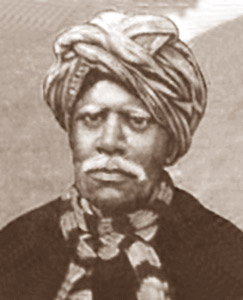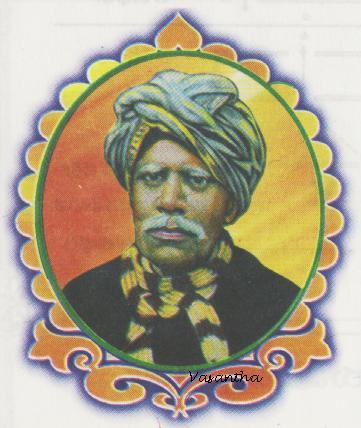<Back to Index>
- Astronomer Petrus Apianus, 1495
- Painter Frans van Mieris the Elder, 1635
- Social Reformer of Andhra Pradesh Kandukuri Veeresalingam, 1848
PAGE SPONSOR


Kandukuri Veeresalingam (Telugu: కందుకూరి వీరేశలింగం) (also known as Kandukuri Veeresalingham Pantulu), (16 April 1848 - 27 May 1919) was a social reformer of Andhra Pradesh. He was born in an orthodox Andhra family. He is widely considered as the man who first brought about a renaissance in Telugu people and Telugu literature. He was influenced by the ideals of Brahmo Samaj particularly those of Keshub Chunder Sen. He got involved in the cause of social reforms. In 1876 he started a Telugu journal and wrote the first prose for women. He encouraged education for women, and started a school in Dowlaiswaram in 1874. He started a social organisation called Hitakarini (Benefactor).
Son of Subbarayudu and Punnamma, he was born on 16 April 1848 in a Brahmin family (6000 Niyogi) at Rajahmundry (now in Andhra Pradesh). When he was six months old, he suffered an attack of small pox, a killer disease in those days, but he survived. His father died when he was four years old and he was adopted and brought up by his paternal uncle, Venkataratnam, as his own son. After a basic grounding in the Indian classics, he joined an English school and attracted attention as a keen scholar with an analytical mind. He was unanimously elected as the best student of the school and was exceptional in his behaviour. He mastered both English and Sanskrit.
His first job was that of a teacher in Korangi village in 1872. After serving as a teacher and later as the head master for two year at Koranki, he moved on to Davaleswaram as head master in an English medium school.
In 1861, he was married to Bapamma Rajyalakshmi. He was then 13 and she was only eight years old. When she grew up, she played an important role in his life, sharing his progressive ideas and extending support to him in his difficult days.
He was
influenced by the Brahmo
Samaj leader,
Atmuri Lakshmi Narasimha. The ideas of Raja
Rammohun
Roy, Iswar
Chandra Vidyasagar and Keshub
Chunder
Sen had
a
powerful impact on him. David Kopf says, “The new social conscience and
consciousness of Unitarianism was in Rammohun almost entirely directed
to the miserable state of Hindu women. He found them uneducated and
illiterate, deprived of property rights, married before puberty,
imprisoned in purdah, and murdered at widowhood by a barbaric custom of
immolation known as sati. One has only to read Rammohun’s works on
social reform to realize that most of it deals with one aspect or
another of man’s inhumanity towards women in Bengal. The conclusion is
that only by freeing women and by treating them as human beings could
Indian society free itself from social stagnation.” Kandukuri
Veeraselingam Pantulu expressed the opinion, “The denigration of women
has ruined our society,” and dedicated his entire life to the cause of
uplift of women in his society. He started a magazine named Vivekavardhini (Knowledge
Improver)
at Davaleswaram, in which he wrote about women’s uplift,
criticised superstitious beliefs among people and rampant corruption
among officials. Initially he used to get it printed at Chennai but
when the magazine picked up in popularity, he set his own press at
Rajahmundry. He launched Satihitabobhini, a special magazine for
women. Through it, he enlightened women about their rights. He
organised the Rajahmundry Social Reform Association in 1878. Initially,
it concentrated on the anti-nautch movement to discourage the hire of
nautch girls for celebration, but later concentrated on widow
remarriage. He
organised the first widow remarriage in the area on 11 December
1881. The groom was Gogulapati Sreeramulu and bride was Gowramma. Many
English Police officials attended the marriage. Pyda Ramakrishnayya of
Kakinada extended financial support for it. However, both of them faced
severe opposition from society. He succeeded in bringing about a change
in the mindset of his people and gradually more and more people
accepted widow remarriage. After the third widow marriage, Eswar Chandra
Vidyasagar sent a message congratulating him. Later a widow orphanage
was established. His progressive thoughts brought in severe criticism
and opposition but he continued unabated. He fought to abolish child
marriages and Kanyasulkam (a kind of dowry given by the groom to the
bride's parents). In 1881,
his contemporary social and religious reformer, Kolkata based Sivanath
Sastri met him at
Rajahmundry, during one of his missionary visits. About his meeting,
Sivanath Sastri writes, “The next day I went by boat to Rajahmundry,
and shall gratefully remember the love and affection of Veerasalingam
and the hospitality of his wife. Veerasalingam’s wife is a remarkable
person. On one hand, she is strong willed, powerful and dutiful. On the
other, she is soft hearted and dedicated to the well being of others.
It is because Veerasalingam got a wife like her that he was able to
carry on with his work in spite of social oppression.” In the History of the Brahmo
Samaj, Sivanath Sastri writes about Kandukuri Veeraselingam Pantulu, “He
constructed the first Brahmo Mandir in the Andhra country at
Rajahmundry in 1887, he constructed a Widows’ Home, a two storied
building and a similar one for the Social Reform Association at Madras;
he started the first theistic high school, the Hithakarini School at
Rajahmundry in 1908; during the same year he willed away all his
property for the benefit of Rajahmundry Widows’ Home and the school,
and placed them under the management of an association, the Hithakarini
Samaj. The movement spread from Rajahmundry to Coconada (presently
Kakinada), Parlakimedi, Palakole, Narsapur, Vijaywada and Tenali.” He is
also credited with the setting up of Brahmo Samaj at Bangalore. Veeresalingam
panthulu
is popularly called Gadhya
Thikkana. He wrote about 100 books
between 1869 and 1919 and introduced the essay,
biography, autobiography and the novel into Telugu literature. His Satyavathi Charitam was the first social novel in Telugu. He wrote Rajasekhara
Charitamu inspired
by Oliver
Goldsmith’s The
Vicar of Wakefied. To him literature was an instrument to fight
social evils. He was a poet of considerable renown. He was
also one of the members of the first Indian
National
Congress meeting
held in 1885. He died
on 27 May 1919. A statue of his has been installed on Beach Road,
Visakhapatnam.